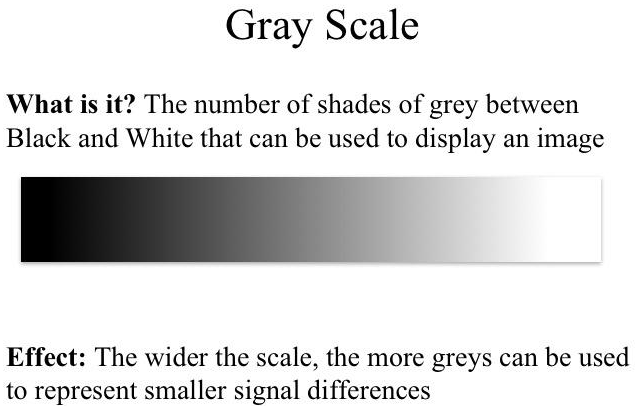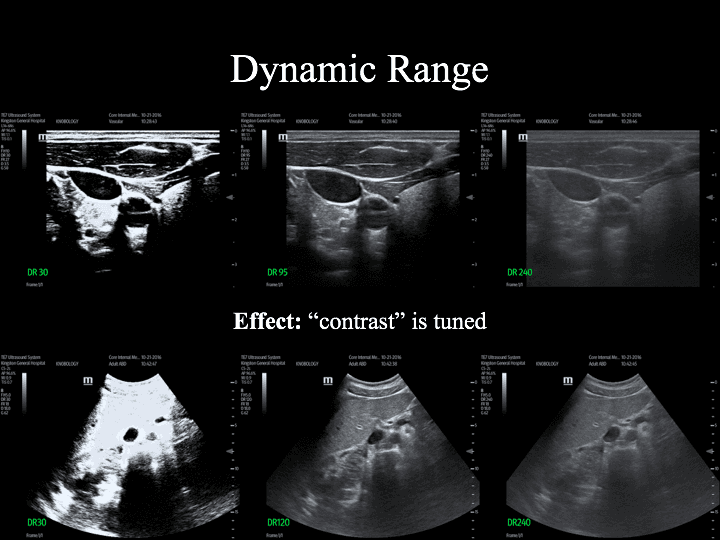Advance Knobology for B-Mode Imaging - Gray Scale, Dyanmic Range, Power
1. Gray Scale
Think of it this way - if you have only seven colours and each of them is assigned a signal to represent, only seven signal can be converted into a visual representation (respective colour assignment).
Think of it this way - if you have only seven colours and each of them is assigned a signal to represent, only seven signal can be converted into a visual representation (respective colour assignment).

2. Dynamic Range (DR)
It is the range of echo intensities due to be processed for display on the monitor with the Gray Scale: Max. Intensity as white and Min. Intensity as black.
It allows you to control the range of echo intensities the Processor will process.
To illustrate this concept, suppose you have gathered all these echo signals displayed on the graph on the right. Some of these signals are meaningful and some are not. You decided to set a threshold (middle Red Line) where all signals with intensity higher than it shall be processed, and all signal intensity lower than it will be filtered.
It is the range of echo intensities due to be processed for display on the monitor with the Gray Scale: Max. Intensity as white and Min. Intensity as black.
It allows you to control the range of echo intensities the Processor will process.
To illustrate this concept, suppose you have gathered all these echo signals displayed on the graph on the right. Some of these signals are meaningful and some are not. You decided to set a threshold (middle Red Line) where all signals with intensity higher than it shall be processed, and all signal intensity lower than it will be filtered.

As you can may imagine, setting the filter too high will result in loss of many meaningful signal resulting in an image of low utility. On the other hand, setting the filter too low will result in detection of many acoustic noises which will distort the image.
Beloware two sets of images displayed at various dynamic ranges
- Upper row: cervical vessels
- Lower row: right upper quadrant

If the DR is low (more signals filtered), there will be less signals to process. Hence, the image will be LESS detailed but with greater contrast.
On the far left where the picture is essentially "Black and White", the DR is low (ie. note the liver of the low dynamic range picture, it is essentially hyperechoic with no tissue texture differentiation).
If the DR is high (less signals filtered), more signals will be processed. Hence, the image will be more detailed but with less contrast (ie. note the liver in the high DR picture, the tissue plane and texture is not well defined).
If the DR is high (less signals filtered), more signals will be processed. Hence, the image will be more detailed but with less contrast (ie. note the liver in the high DR picture, the tissue plane and texture is not well defined).
3.
Power
is different from Gain. Think of it this way. Power refers to the energy required to GENERATE the pulse wave BEFORE emission from the transducer whereas Gain affects the signals AFTER the pulse wave is received.
The more Power, the deeper the wave can travel and the more energy reserved to buffer attenuation. However, it can increase acoustic "noise", and, also, may cause harm to biological tissues.
As a general rule: Keep the Power at the minimum and maximize Gain to compensate.
DO NOT increase Power - particularly for indications involving delicate tissues such as the eye (ocular PoCUS).
The more Power, the deeper the wave can travel and the more energy reserved to buffer attenuation. However, it can increase acoustic "noise", and, also, may cause harm to biological tissues.
As a general rule: Keep the Power at the minimum and maximize Gain to compensate.
DO NOT increase Power - particularly for indications involving delicate tissues such as the eye (ocular PoCUS).
Take Home Messages:
- Rarely have to change these settings, but these function and concepts are introduced so that should you encounter them in the literature, you will have a basic understanding to comprehend the text
